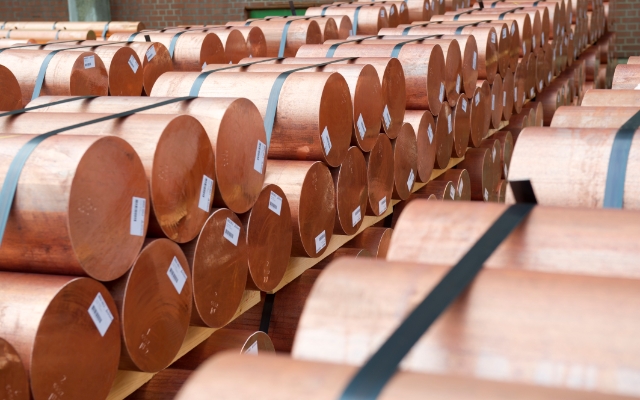How Copper Products Add To Lasting Practices in Numerous Markets
In eco-friendly energy systems, for instance, copper improves the performance of solar and wind modern technologies, while its application in building and construction decreases waste with longevity. As markets seek to take on even more lasting methods, the role of copper could confirm critical in achieving ecological goals.
Copper in Renewable Power
Copper plays a vital role in the development of eco-friendly energy technologies, acting as an important conductor in different applications. Its extraordinary electrical conductivity and resistance to deterioration make it a perfect material for electrical wiring, which is necessary in solar panels, wind turbines, and power storage systems. In solar photovoltaic systems, copper is utilized in the interconnections and wiring, allowing reliable power conversion from sunlight to power.
In wind power, copper is important to the generators and transformers that transform kinetic energy right into electrical energy, making sure optimal performance and reliability. In addition, the demand for electrical cars (EVs) is boosting, with copper being an essential component in batteries, electric motors, and charging framework. The transition to EVs considerably boosts the demand for copper, as these automobiles generally make use of four times a lot more copper than standard internal burning engine cars.
As the globe seeks to reduce environment modification and shift to lasting power sources, copper's duty comes to be significantly critical. The product not just enhances the effectiveness and sturdiness of renewable resource systems but additionally sustains the more comprehensive objective of minimizing greenhouse gas discharges and promoting a lasting future.
Eco-Friendly Building Products
In the last few years, there has actually been a remarkable shift towards the adoption of environment-friendly construction products in action to growing ecological issues. This change is encouraged by the need for lasting options that lessen environmental footprints while keeping architectural honesty and visual appeal.
Copper, recognized for its durability and recyclability, has actually become a principal in this market. It can be made use of in roof covering, pipes, and electrical systems, contributing to power effectiveness and minimizing waste. Copper's longevity indicates fewer substitutes over time, further enhancing its sustainability account.
In addition, materials such as bamboo, reclaimed timber, and reused steel are acquiring appeal. These options not just provide decreased ecological impact yet additionally promote resource conservation. As constructing codes significantly highlight sustainability, engineers and contractors are incorporating these materials into their tasks, cultivating advancement in design.
The enhancing fostering of eco-friendly construction materials mirrors a more comprehensive commitment to sustainability in the constructed atmosphere. By focusing on these materials, the building and construction market can substantially decrease its carbon impact, align with regulative criteria, and support a much healthier community for future generations. This trend marks a critical action in the direction of a more lasting future in building and construction.
Copper's Duty in Health care
Current studies have highlighted the considerable role of copper in medical care settings, especially because of its antimicrobial homes. Copper surface areas have been shown to reduce the existence of pathogens, including bacteria and viruses, by up to 99.9% within a brief duration. This amazing efficiency makes copper a vital material for high-touch surface areas in medical facilities, such as doorknobs, bed rails, and IV posts, thus adding to improved infection control measures.
Along with its direct antimicrobial impacts, copper additionally contributes in the wider context of healthcare facility sustainability (Copper Products). By integrating copper into clinical equipment and furnishings, health care centers can decrease the occurrence of healthcare-associated infections (HAIs), which not just improves client outcomes but also lowers the prices related to extensive healthcare facility stays and added treatments
Moreover, copper's durability and recyclability align with sustainable techniques, permitting for responsible source administration. As medical care systems increasingly prioritize both person safety and security and environmental stewardship, the integration of copper products is coming to be extra widespread. This dual benefit emphasizes copper's essential contribution to a much healthier, more secure, and a lot more sustainable health care atmosphere.
Sustainability in Transport

Additionally, copper's toughness and rust resistance add to the long life of transport framework (Copper Products). In rail systems, for example, copper elements boost the dependability and performance of signaling and power systems, crucial for decreasing hold-ups and energy usage. In addition, copper's role in renewable resource systems, such as solar and wind, supports sustainable transportation options by giving tidy power for electrical transportation choices
Investments in copper innovation not just foster sustainability however likewise stimulate economic growth and work production in eco-friendly markets. As industries strive to why not try here fulfill rigid ecological regulations, the application of copper products in transport becomes a crucial strategy in achieving sustainability objectives and advertising a cleaner, much more effective future.
Copper and Round Economic Situation
As the world increasingly accepts sustainability, the role of copper in the circular economy ends up being ever before more significant. Copper's intrinsic residential or commercial properties-- such as its conductivity, recyclability, and durability-- setting it as a crucial material in a resource-efficient economy. The circular economic situation aims to minimize waste and take full advantage of source usage through recycling and reusing materials, and copper master this respect.
The steel can be recycled forever without loss of top quality, making it an optimal candidate for sustainable practices throughout numerous markets, consisting of building, electronics, and renewable resource. By recovering and recycling copper from end-of-life products, markets can substantially minimize the requirement for virgin products, consequently decreasing environmental influences connected with mining and handling.
Additionally, the integration of copper into round economic climate structures not just preserves resources however also cultivates innovation. Organizations that prioritize copper recycling add to a much more lasting supply chain, enhancing their competitiveness while lining up with regulatory needs and customer preferences for ecologically liable items.
Conclusion
To conclude, copper products considerably contribute to sustainable practices across numerous sectors. Their essential function in improving renewable resource innovations, promoting green construction materials, supporting infection control in healthcare, promoting lasting transport, and personifying the concepts of a round economy emphasizes the versatility and value of copper. basics By incorporating copper right into various applications, industries can achieve better effectiveness, decrease ecological impact, and line up with worldwide sustainability objectives, eventually fostering a more sustainable future.

Copper's outstanding conductivity makes it a favored material in electrical vehicle (EV) systems, improving power efficiency and performance. In addition, copper's function in renewable power systems, such as solar and wind, supports lasting transportation options by providing tidy power for electric transit alternatives.
Their essential function in enhancing sustainable energy technologies, promoting eco-friendly building and construction materials, sustaining infection control in health care, helping with lasting transport, and embodying the concepts of a round economic climate highlights the adaptability and significance of copper.
Comments on “From Art to Functionality: The Many Applications of Unique Copper Products”